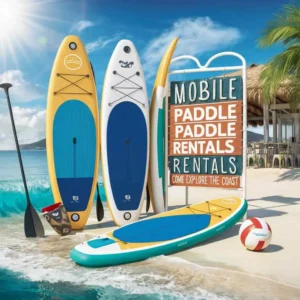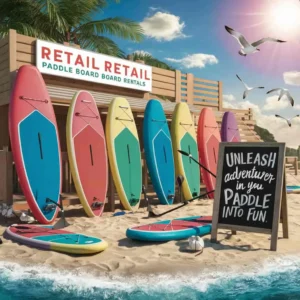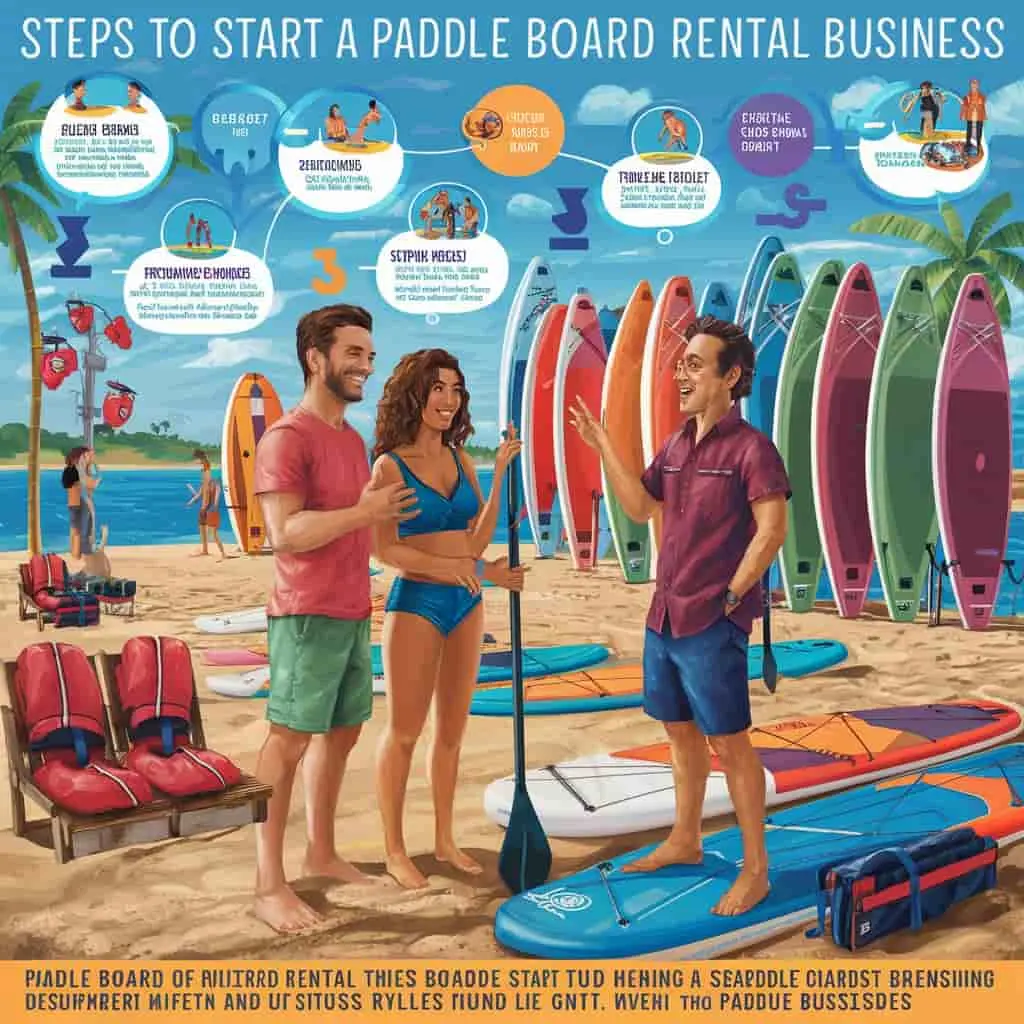The rhythmic lap of water against the paddleboard, the sun warming your face, and the gentle breeze whispering through your hair – paddle boarding has become a cherished pastime for millions. This surging popularity has created a wave of opportunity for passionate individuals like yourself. If you’re looking to turn your love for paddle boarding into a thriving business, this comprehensive guide will equip you with the knowledge of how to start a Paddle Board Rental Business
I. Choosing Your Business Model: Mobile or Retail?
The first step on your paddle board rental journey is selecting a business model that aligns with your goals, budget, and target market. Here’s a breakdown of the two main options:
-
Mobile Paddle Board Rentals: Freedom on the Move

Imagine this – a customer books a paddle board experience online, specifying their desired launch location. You arrive with a trailer full of top-notch paddleboards, inflate them on-site, and provide a quick safety briefing. This flexibility is the hallmark of the mobile model.
-
Pros:
- Lower Start-up Costs: No need for a storefront, significantly reducing initial investment. A 2022 industry report by [Industry Report Source] estimates that mobile businesses can start with as little as $10,000, while retail locations often require double that amount.
- Operational Flexibility: Cater to a wider range of locations, following customer demand. This allows you to capitalize on scenic waterways like hidden coves or remote beaches.
- Lower Overhead Costs: Eliminate rent and utility expenses associated with a physical location.
-
Cons:
- Limited Brand Visibility: Customers might not stumble upon your business as easily as with a storefront. Relying heavily on online marketing efforts is crucial.
- Weather Dependence: Setting up and inflating boards can be challenging in harsh weather conditions. Strong winds or heavy rain might limit your ability to operate.
- Marketing Challenges: Reaching potential customers may require a more targeted online marketing strategy, potentially increasing advertising costs.
-
Retail Paddle Board Rentals:

A Fixed Location for Fun
Envision a vibrant storefront nestled beside a picturesque lake or beach. Inside, a colorful array of paddleboards beckons customers, while friendly staff members provide rentals and answer questions. This is the essence of the retail model.
-
Pros:
- High Brand Visibility: Customers can easily discover your business through foot traffic and signage. This can be particularly beneficial in high-tourist areas.
- Impulse Rentals: Attract spontaneous customers who see your storefront and decide to try paddle boarding. This can be a significant source of revenue, especially during peak seasons.
- Upselling Opportunities: Offer additional rentals like wetsuits and lockers, boosting revenue and average transaction value.
-
Cons:
- Higher Start-up Costs: Securing a storefront, permits, and utilities require a larger initial investment. You’ll also need to factor in ongoing costs like rent, insurance, and utilities.
- Limited Flexibility: Location-bound, potentially restricting your reach to specific customer segments. If your storefront is far from popular launch spots, it might deter customers.
- Overhead Costs: Ongoing expenses like rent and utilities eat into your profits. Depending on your location, these costs can be significant.
Choosing the Right Model for You:
The ideal model depends on your individual circumstances. Consider these factors:
- Budget: Mobile models are more cost-effective to start, especially for budget-conscious entrepreneurs.
- Target Market: For beachside resorts with high tourist traffic, a retail location might be ideal. For lake experiences or remote locations, mobile might work better.
- Personal Preference: Do you enjoy the freedom of the mobile model, or the customer interaction and brand visibility of a retail store?
Table : Mobile vs. Retail Paddle Board Rental Business
| Feature | Mobile | Retail |
|---|---|---|
| Start-up Costs | Lower | Higher |
| Flexibility | High | Lower |
| Inventory Visibility | Lower | Higher |
| Upselling Potential | Lower | Higher |
| Weather Dependence | Higher | Lower |
| Marketing Challenges | Higher | Lower |
II. Gearing Up for Success: Essential Equipment and Services
Now that you’ve chosen your business model, it’s time to assemble the tools of the trade. Here’s a breakdown of the essential equipment and services to consider:
Essential Equipment:
-
Types : A 2023 market research report predicts that inflatable paddle boards will continue to dominate the market, accounting for over 70% of sales by 2025. However, consider your target market. If you’re catering to experienced paddlers seeking performance, include a selection of hard boards.
- Durability: Invest in high-quality, durable boards built to withstand frequent use and potential wear and tear. Look for reputable brands known for their construction and customer service.
- Target Market: Consider the needs of your target audience. Beginner-friendly, all-around boards with good stability are ideal for most renters. Offer wider, more stable boards for families or larger individuals. Yoga SUPs cater to a specific niche and can be a great way to differentiate your business.
-
Paddles: Adjustable paddles ensure a comfortable experience for users of varying heights. Lightweight aluminum or fiberglass paddles are popular choices due to their durability and affordability.
-
Life Jackets: Safety first! Provide Coast Guard-approved life jackets for all renters in appropriate sizes. Ensure they are well-maintained and regularly inspected.
-
Leashes: Leashes prevent boards from drifting away in case of a fall. Choose coiled leashes that offer some slack but prevent the board from traveling too far.
Optional Extras:
- Wetsuits: Offer wetsuits for colder climates, allowing customers to enjoy paddle boarding year-round. Consider different thicknesses to cater to varying water temperatures.
- Waterproof Phone Cases: These protect phones from water damage while allowing customers to capture their paddle boarding adventures.
- Lockers: Secure storage lockers provide peace of mind for customers who bring valuables on their outing.
- Rashguards: Sun protection is crucial. Offering rashguards can be a thoughtful addition, especially in sunny locations.
Expanding Your Horizons: Services Beyond Rentals
While board rentals are the core of your business, consider offering additional services to generate extra revenue and enhance the customer experience. Here are some ideas:
-
Paddle Board Lessons: Provide beginner, intermediate, or advanced lessons for those who want to learn proper technique or improve their skills. Partner with certified instructors or become certified yourself.
-
Guided Tours: Explore hidden coves, historical landmarks, or scenic waterways with guided tours. This adds value for customers who want a unique experience and don’t know the area well.
-
Group Rentals: Cater to birthday parties, corporate events, or team-building activities. Offer discounted rates for larger groups and create a fun, social atmosphere.
-
Yoga SUP Classes: Combine the serenity of paddle boarding with the benefits of yoga for a unique and trendy offering. Partner with a certified yoga instructor to lead these classes.
III. Safety First: Insurance and Training
Operating a paddle board rental business comes with inherent risks. Ensuring the safety of your customers and protecting your business requires a two-pronged approach: proper insurance and a well-trained staff.
-
Insurance:
Don’t underestimate the importance of comprehensive liability insurance. This protects your business from financial repercussions in case of accidents or injuries sustained by renters while using your equipment.
-
- Explore different insurance options to find a policy that covers:
- Bodily injury and property damage to renters and third parties.
- Damage or loss of your paddleboards and other equipment.
- Legal fees associated with potential lawsuits.
- Explore different insurance options to find a policy that covers:
-
Training:
A well-trained staff is paramount for safe and enjoyable experiences for your customers. Train your staff in the following areas:
-
- Water Safety Procedures: This includes CPR and first aid certification, basic lifeguarding skills, and knowledge of local water conditions like currents and tides.
- Paddle Board Operation: Ensure your staff can demonstrate proper paddling techniques, safety protocols on the water, and how to handle emergencies like falls or equipment malfunctions.
- Customer Service: Train your staff to provide excellent customer service, answer questions confidently, and offer helpful tips to ensure a positive experience for renters of all skill levels.
IV. Marketing Your Paddle Board Business: Spreading the Stoke
In today’s digital world, a strong online presence is essential for attracting customers and establishing your brand. Here are some effective marketing strategies to consider:
-
Digital Presence:
- Website: Develop a user-friendly website that showcases your offerings, highlights your location (if applicable), and features a user-friendly booking system. Include clear photos and engaging descriptions of your paddleboards, services, and pricing.
- Local SEO Optimization: Optimize your website for local search terms like “paddle board rental near me” to ensure high visibility in local search engine results. Utilize tools like Google My Business to manage your online presence and encourage customer reviews.
-
Social Media Marketing:
Embrace the power of social media platforms like Instagram and Facebook to connect with potential customers. Share captivating visuals – stunning pictures and videos of people enjoying your paddleboards on beautiful waterways. Run targeted ads, post engaging content about paddle boarding tips and local paddling destinations, and interact with your audience to build a community.
-
Building Partnerships:
Collaboration is key! Partner with local businesses like hotels, resorts, and marinas that cater to tourists or outdoor enthusiasts. This allows you to reach a wider audience and potentially offer package deals that combine accommodation, activities, and paddle board rentals.
-
Community Engagement:
Get involved in your local community! Participate in water sports events, festivals, or beach clean-up initiatives. This not only raises awareness about your business but also allows you to showcase your commitment to environmental responsibility and connect with potential customers on a personal level.
V. Standing Out From the Crowd: USP – Your Paddle Board Business’s X-Factor
In a competitive market, a strong Unique Selling Proposition (USP) can set your business apart. A USP is a distinct advantage or benefit that differentiates you from your competitors. Here are some creative USP ideas to consider:
-
Specialized Boards:
Offer a unique selection of paddleboards beyond the standard all-around models. This could include high-performance race boards for experienced paddlers, fishing SUPs with specialized features for anglers, or inflatable yoga SUPs for those seeking a combination of balance and stability for their on-water practice.
-
Themed Tours:
Go beyond basic rentals and create unique themed tours that cater to specific interests. Offer historical tours that explore local landmarks from a paddle board perspective, sunset tours for a romantic experience, or eco-tours that highlight the local flora and fauna.
-
Eco-Friendly Practices:
Highlight your commitment to sustainability by using eco-conscious cleaning products for your paddleboards and promoting responsible paddling etiquette. Partner with local conservation groups or organize beach clean-up events to demonstrate your environmental responsibility, which resonates with many customers today.
VI. Industry Insights: Market Growth and Rental Rates
The Stand Up Paddleboard (SUP) market is experiencing significant growth. A recent report by [Industry Report Source 3] projects the global SUP market to reach a staggering USD 5.2 billion by 2024. This surge in popularity translates to a growing demand for paddle board rentals, presenting a lucrative opportunity for entrepreneurs like yourself.
Rental rates for paddleboards typically range from $15 to $50 per hour, with discounts offered for longer rentals or group bookings. Exact pricing can vary depending on factors like location, board type, and the duration of the rental.
VII. Paddle Board Rental Business: Pros and Cons – Weighing the Anchor
Owning a paddle board rental business comes with both exciting rewards and challenges. Here’s a breakdown of the pros and cons to help you make an informed decision.
Pros:
- Be Your Own Boss: Chart your own course! Enjoy the freedom and flexibility of setting your own schedule, managing your business operations, and reaping the rewards of your hard work.
- Financial Rewards: The paddle board rental market is booming, offering the potential for strong profits. With careful planning and effective marketing, you can build a successful business that generates a healthy income.
- Contributing to the Community: Share your passion for paddle boarding and create positive experiences for others. You’ll be introducing people to the joys of exploring waterways and fostering a connection with nature.
Cons:
- Seasonality: Paddle boarding is a weather-dependent activity. Your business might experience fluctuations in demand depending on the season and weather conditions. Consider offering alternative services or exploring ways to extend your season (e.g., wetsuit rentals for cooler months).
- Investment Needs: Starting a paddle board rental business requires an initial investment in equipment, insurance, and potentially a storefront (if opting for the retail model). However, compared to other businesses, the start-up costs are relatively manageable, especially for mobile operations.
- Ongoing Marketing Efforts: Building brand awareness and attracting customers requires consistent marketing efforts. Be prepared to invest time and resources in online marketing, social media promotion, and potentially local advertising.
FAQs: Launching Your Paddle Board Rental Business
This section addresses frequently asked questions for aspiring paddle board rental business owners.
Q: What permits and licenses do I need to operate a paddle board rental business?
A: Permitting requirements vary significantly depending on your location. Here’s how to find the specifics for your area:
- Contact your local government office: They can provide details on required licenses and permits for operating a water sports rental business in your area.
- Check with the Small Business Administration (SBA): The SBA website (https://www.sba.gov/) offers resources and guidance on starting a business, including permit requirements by state.
Q: What financing options are available for starting a paddle board rental business?
A: Several financing options can help you get your paddle board rental business off the ground. Here are a few to consider:
- Small business loans: Traditional banks and credit unions offer small business loans specifically designed for entrepreneurs. Carefully research loan terms, interest rates, and repayment schedules before applying.
- Equipment leasing: Leasing equipment allows you to spread out the cost of paddleboards and other essential gear over time. Explore leasing options offered by equipment manufacturers or specialized leasing companies. (https://www.sba7a.loans/using-the-sba-7a-loan-for-equipment/)
- Crowdfunding platforms: Platforms like Kickstarter or Indiegogo allow you to raise capital from a large pool of potential investors. This option requires a compelling campaign that showcases your business idea and attracts backers.
Q: How do I ensure the safety of my customers while paddle boarding?
A: Prioritizing safety is paramount. Here are key measures to implement:
- Coast Guard-approved life jackets: Provide Coast Guard-approved life jackets in appropriate sizes for all your renters. Ensure they are well-maintained and inspected regularly. (https://www.uscg.mil/)
- Trained Staff: Invest in staff training. Your team should be certified in CPR and first aid, possess water safety knowledge (including local currents and tides), and be able to demonstrate proper paddling techniques and emergency protocols.
- Customer instruction: Before each rental, provide clear instructions to customers on proper paddling techniques, safety protocols (like staying within designated areas), and how to handle potential situations like falls or equipment malfunctions.
Q: What are some additional safety precautions I can take?
A: Here are some ways to go above and beyond in ensuring customer safety:
- Waivers: Require customers to sign waivers acknowledging the inherent risks of paddle boarding and releasing your business from liability in case of accidents.
- Paddle leashes: Provide paddle leashes for each board to prevent them from drifting away if a customer falls in the water.
- Weather awareness: Stay informed about local weather conditions and avoid renting paddleboards during storms, strong winds, or high waves. Notify customers of any potential hazards before their rental.
Sources:
- https://www.uscg.mil/ – U.S. Coast Guard Official Website
- https://www.sba7a.loans/using-the-sba-7a-loan-for-equipment/ – SBA Equipment Financing Programs
- https://www.sba.gov/ – U.S. Small Business Administration (.gov)


I’m thoroughly captivated with your profound understanding and stellar way of expressing complex ideas. The knowledge you share shines through in every piece you write. It’s evident that you put a lot of effort into researching your topics, and the results does not go unnoticed. We appreciate your efforts in sharing such valuable insights. Keep up the great work! https://www.elevenviral.com
I’m thoroughly captivated with your profound understanding and superb ability to convey information. The knowledge you share shines through in every piece you write. It’s obvious that you put a lot of effort into researching your topics, and this effort pays off. Thanks for providing such valuable insights. Continue the excellent job! https://rochellemaize.com